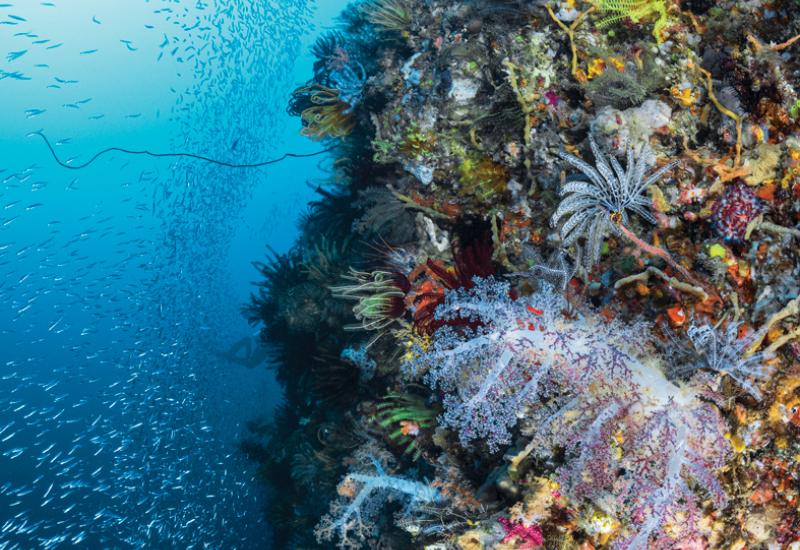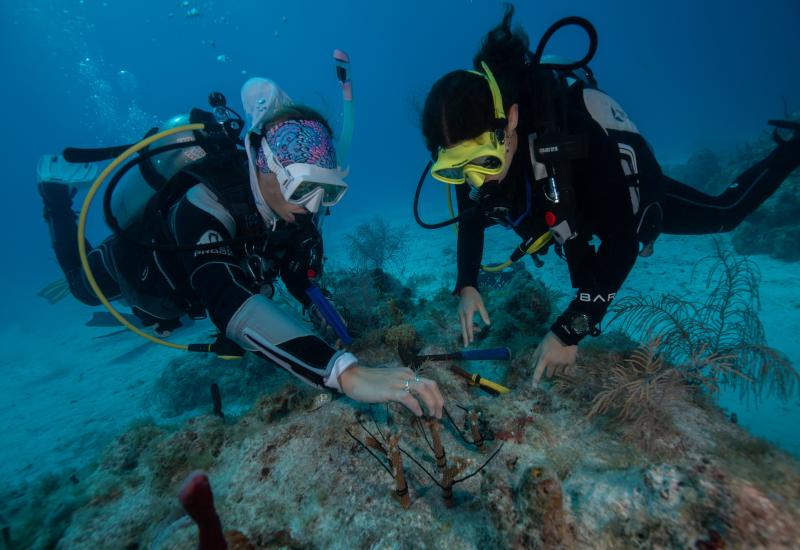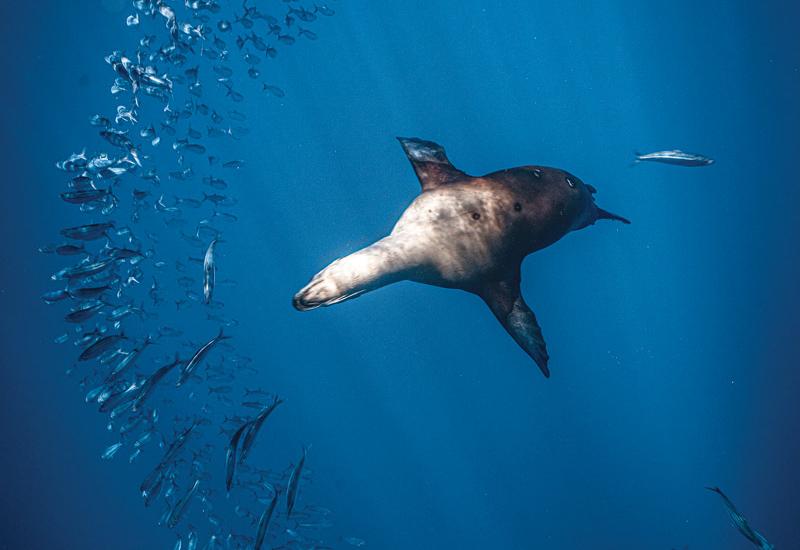Seven Historic Florida Wrecks
 |
| A navigation error grounded the cargo ship Copenhagen. |
March 2001
By Linda Reeves
The difference between an everyday wreck dive and one that sends a shiver down your spine is a palpable sense of history. Knowing the story behind a wreck adds a whole new dimension to the dive--that of the imagination.
Armed with historical context, the mind fills in the gaps, allowing us to see the vessel in her prime, to hear the roar of her cannons, the steady chug of her steam engine or the cries of her ill-fated crew.
That's what makes Florida's Underwater Archaeological Preserves so interesting. These submerged parks are spread across the Sunshine State from the Panhandle to the Florida Keys, and they offer a glimpse of history as far back as the 1700s. State archaeologists have done the research for you. Each site is fully explained with brochures, laminated maps, markers and, in some cases, topside museum displays. All you need is your C-card and imagination.
USS Massachusetts (BB-2)
Location: South end of Caucus Shoal, just outside Pensacola Pass.
History: In her day, there was no more advanced weapon than the USS Massachusetts. In a world still dominated by wooden ships, the steam-powered Mass was 350 feet of solid steel and awesome firepower--two 13-inch gun batteries, four 8-inch secondary batteries, four torpedo tubes and a number of smaller weapons. Her armor belt was 18 inches thick and the ship would later be equipped with one of the first wireless telegraphs.
Launched in 1893, the Mass and her sister ships, Indiana and Oregon, represented a quantum leap in naval warfare, but were soon eclipsed by even bigger and better vessels. The Mass saw combat in the Spanish-American War, but by the start of World War I she was relegated to light duty as a training vessel. When she was decommissioned in 1919, her sister ships had already been scrapped, but a different fate awaited the Massachusetts. In 1921, she was towed to Pensacola, scuttled in shallow water and used as a target for coastal artillery batteries. Ironically, it was this ignoble end that preserved her place in history as the oldest U.S. battleship in existence.
Dive: Despite the battering of more than 100 artillery rounds and her advanced age, the hull remains remarkably intact. Half-buried in the white sand bottom at 26 feet, the wreck sports a heavy coating of marine growth and is home to fish life from baitfish to amberjack. Tidal changes can mean strong currents on the site, but at high and low tides the conditions are generally clear and calm. The wreck is also a popular fishing site, so divers should take gloves and carry a knife.
Details: Several Pensacola-area dive shops visit the USS Massachusetts and offer brochures and guides to the site. They include: Gulf Breeze Dive Pros, (850) 934-8845; Gulf Coast Dive Pros, (850) 456-8845; Scuba Shack, (850) 433-4319; and Divers Den, (850) 438-0650.
City of Hawkinsville
||
|---|
|

|
| City of Hawkinsville wreck beneath the Suwanee River.|
Location: In the Suwannee River, near Old Town, about 40 miles west of Gainesville.
History: Before highways and railroads revolutionized transportation, the best way in and out of north-central Florida was by steamboat. From 1834 to the 1920s, nearly 50 vessels traveled the Suwannee River delivering everything from mail to passengers to commercial goods.
Put into service in 1900 hauling timber, the 141-foot-long City of Hawkinsville was one of the largest riverboats to cruise the Suwannee, and one of the last. It's believed that Hawkinsville delivered materials used to build the railroad trestle that would link the area to the outside world and ultimately put riverboats out of business. The steamboat was abandoned and sank in 1922, forgotten until local divers began exploring the wreck in the 1960s.
Dive: City of Hawkinsville is located on the west bank of the Suwannee River about 100 yards south of the Old Town railroad trestle. Her wooden hull and paddle wheel are remarkably intact and her steel machinery well-preserved.
Access to the site is by boat only. Although the dive is only 18 feet deep, swift currents and low vis (usually less than 10 feet) make it an advanced dive. Sharp edges and tangles of fishing line on the wreck make gloves, an underwater light and a knife mandatory.
Details: Check river conditions by calling the Suwannee River Water Management District at (800) 226-1066. Delay the dive if the river is high or if the visibility is less than three feet. For wreck information, call the Fanning Springs Chamber of Commerce, (352) 463-9089, or Suwannee River Scuba, (352) 463-7111.
Urca de Lima
||
|---|
|

|
| A 1715 hurricane sank the Spanish merchant ship Urca de Lima.|
**
Location:** About half a mile north from the Fort Pierce Inlet and Pepper Park.
History: In the 1700s, Spain retained world-power status largely through the treasure it extracted from the New World. The Florida peninsula served as a convenient landmark that ships would follow north before turning east to cross the Atlantic.
In 1715, this Spanish merchant ship was part of an 11-ship flotilla that would never make the crossing. Caught in a hurricane, Urca de Lima crashed onto a shallow reef near what is now Fort Pierce.
Dive: The wreck site lies 200 yards from shore in the first reef line. With a maximum depth of about 15 feet, Urca de Lima is a favorite site for beach divers and snorkelers. Five replica cannons have been placed near the wreck to enhance the area. The best time to visit is during summer months when seas are calm and visibility peaks at 50 feet. Typically, there is no current and waters generally average in the 80Fs.
Details: Admission and parking are free at the park. Dive Odyssea, (561) 460-1771, caters to those interested in visiting the site and supplies brochures and guides. Artifacts from the wreck are on display at St. Lucie County Historical Museum (561-462-1795), the Museum of Florida History (904-488-1484) and McLarty Treasure Museum (561-589-2147).
 |
| Still sturdy after all these years, the steel wreckage of USS Massachusetts is a popular diving and fishing site. |
San Pedro
Location: Off Islamorada in the Florida Keys National Marine Sanctuary, a little over one mile south of Indian Key.
History: Another storm victim, this Spanish ship sank in the Florida Keys during a 1733 hurricane. Loaded with silver and porcelain, the 287-ton galleon was traveling in an armed convoy on its way back to Spain. The fleet was heading through the Straits of Florida on its way back to Spain when the deadly storm hit. San Pedro and all but one of her 21 companion ships were tossed onto the reefs. Rescue vessels from Cuba recovered the cargo and refloated many of the vessels, but the San Pedro was too heavily damaged.
Dive: San Pedro sits in 18 feet of water in the Florida Keys National Marine Sanctuary where she is marked with mooring buoys. Snorkelers and divers can swim over the coral-shrouded ballast stones of the wreck, which swarms with tropical reef fish. Shallow depths, clear water and the absence of currents make the wreck an easy site for divers of all skill levels.
Details: Brochures and underwater guides are available from local dive shops, including Lady Cyana Divers, (305) 664-8717, and Bud 'n Mary's Dive Center, (305) 664-2211.
SS Copenhagen
Location: South of Hillsboro Inlet, off Pompano Beach.
History: In the late 1800s, sailors didn't entirely trust steam power, so most ships were double-rigged as sailing vessels--just in case. This single-screw steamer, built in 1898, was no exception. The 325-foot steel-hulled ship was rigged as a schooner, but the real power came from three triple-expansion steam engines.
A navigational error ended the ship's career as a trans-Atlantic cargo hauler on the morning of May 26, 1900. Copenhagen was en route from Philadelphia to Havana when she ran too close to shore and slammed into the reef at eight knots--her full speed. The ship was declared a total loss.
Dive: The wreck is in 15 to 30 feet of water just outside the second reef line near the Pompano Drop Off. Much of the ship's structure has been overgrown by a reef that is home to everything from tropical fish to sea turtles and lobster. Accessible by beach or boat, Copenhagen is a great shallow dive and snorkel site. Visibility varies due to the close proximity to the inlet, but water is clearest on an incoming tide.
Details: Pro Dive International, (800) PRO-DIVE, and Lighthouse Dive Center, (954) 782-1100, offer charters to the wreck.
SS Tarpon
Location: Gulf of Mexico, just over nine miles from the Panama City jetties.
History: For 35 years, SS Tarpon was a regular fixture along the Florida Gulf Coast. The 130-foot steamer made weekly cargo and passenger runs to six Panhandle ports between Mobile, Ala., and Panama City, and Capt. Willis Barrow took great pride in maintaining strict schedules regardless of the cargo or the conditions. He was quoted as saying, "God makes the weather, and I make the trip."
On Aug. 30, 1937, the ship departed on its final cruise. Loaded at Mobile with 200 tons of general cargo, the Tarpon headed east. At Pensacola, she took on more cargo, including 200 barrels of fuel oil and 15 tons of fresh water, wallowing out into rising seas with barely five inches of freeboard. By the next morning, a full gale was blowing and the bilges could no longer keep up with a leak in the hull. Swamped below decks, the ship began to list and settle in the water despite attempts to lighten the load and run the ship toward shore. Eighteen people--including the 81-year-old Barrow--were lost.
Dive: Tarpon lies on a sandy bottom in 95 feet of water, situated parallel to shore. The site is accessible by boat year-round, and water clarity is generally good. During the summer, seas are usually calm with temperatures in the 80Fs. The wreck also offers a wealth of sea life including big amberjacks, barracuda and large schools of baitfish.
Details: Brochures and guides are available at the Tarpon display in the Museum of Man in the Sea, Panama City Beach, (850) 235-4101. Several Panama City dive shops visit the wreck, including Hydrospace Dive Shop, (850) 234-3063, and Panama City Dive Center, (850) 235-3390.
Half Moon
||
|---|
|

|
| The newest state preserve is the wreck of the sailing yacht Half Moon near Key Biscayne.|
Location: Just outside Bear Cut, near Miami's Key Biscayne.
History: An aristocrat's plaything, a spoil of war and a floating saloon--all roles played by this fast 154-foot luxury schooner.
Christened in 1908 as Germania, the yacht was a wedding gift to a German count, and she became famous in European racing circles. The ship happened to be in Cowes, England, for a regatta at the outbreak of World War I and was seized as a prize of war. Auctioned off, the boat changed hands, names and ports before ending up in Miami in the late 1920s. By 1930, the once-proud yacht was a floating cabaret and fishing barge anchored off Miami, but a storm that year ripped the boat free of her moorings and smashed it onto a shoal.
Dive: Today, the wreck lies broken, but the partially buried hull is still largely intact and many distinct features of the wreck are recognizable. A popular site with snorkelers, the wreck is in 10 feet of water and covered with soft corals and sponges.
Details: The newest of the preserves, Half Moon was to be officially designated in February 2001. A museum display of the wreck, including the ship's original bell, will be on display in the new Biscayne Nature Center, (305) 642-9600. Access to the wreck is available by private boat or Miami-area dive shops, including South Beach Divers, (305) 531-6110.
The Rules
Look, But Don't Take.
It's illegal to disturb or remove artifacts from all shipwrecks in state waters, including the underwater archaeological preserves.
Fly the Colors.
State law requires divers to fly a dive flag and stay within 100 feet of it.
No Anchors.
All underwater archaeological preserves, except the USS Massachusetts, are marked with mooring buoys to prevent anchor damage to the wrecks. If necessary, anchor in the sand away from the wreck to avoid damage.
What is a State Underwater Archaeological Preserve?
In 1987, the State of Florida began designating wrecks as archaeological preserves in order to protect sites from damage and to promote visits by divers.
"These wrecks are like time capsules. They freeze a particular moment of Florida's maritime history," says Dr. Roger Smith, state underwater archaeologist with the Division of Historical Resources. "As divers we all need to protect our submerged cultural resources so that future divers can share in the excitement of Florida's maritime history."
Each wreck site is marked with an underwater plaque and most have mooring buoys, while brochures detailing the wreck's history and laminated site guides are available at tourist centers, local museums and dive shops.
For more information or to nominate a wreck as a preserve, contact Della Scott at (850) 487-2299.
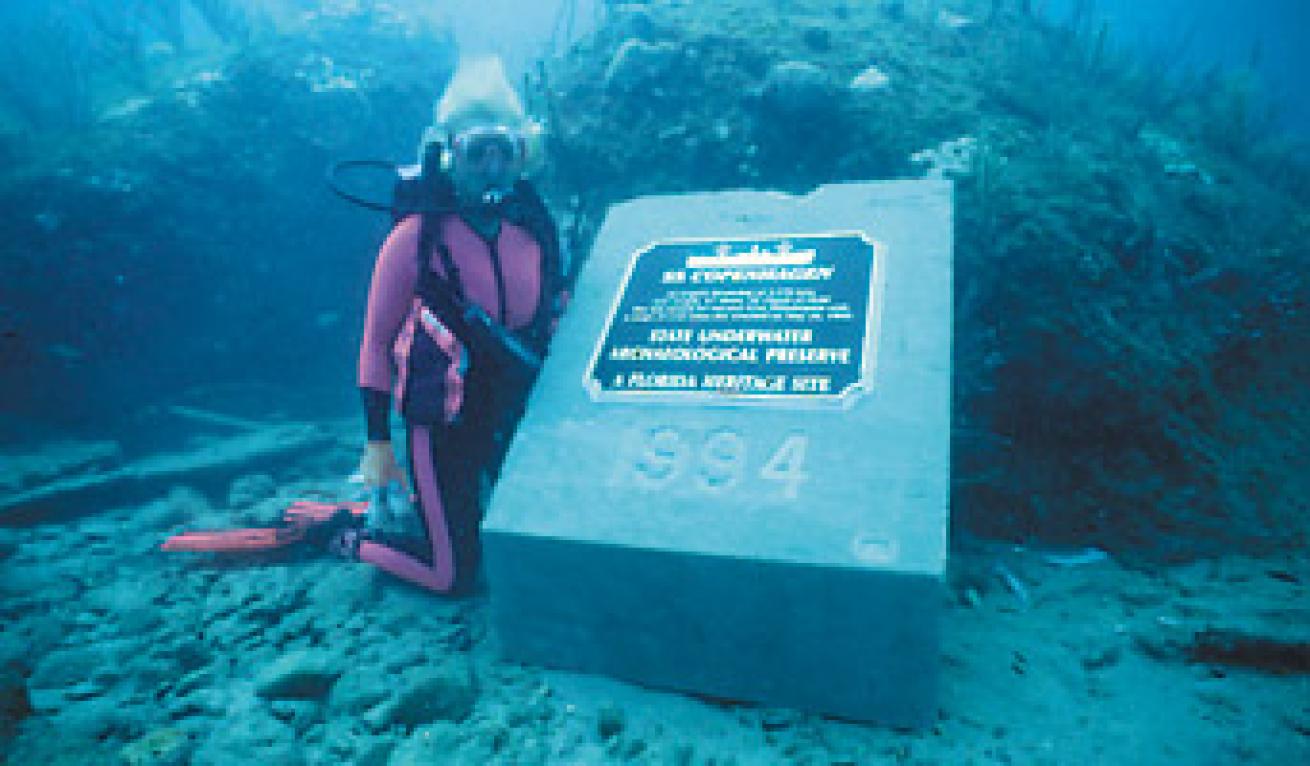
A navigation error grounded the cargo ship Copenhagen.
March 2001
By Linda Reeves
The difference between an everyday wreck dive and one that sends a shiver down your spine is a palpable sense of history. Knowing the story behind a wreck adds a whole new dimension to the dive--that of the imagination.
Armed with historical context, the mind fills in the gaps, allowing us to see the vessel in her prime, to hear the roar of her cannons, the steady chug of her steam engine or the cries of her ill-fated crew.
That's what makes Florida's Underwater Archaeological Preserves so interesting. These submerged parks are spread across the Sunshine State from the Panhandle to the Florida Keys, and they offer a glimpse of history as far back as the 1700s. State archaeologists have done the research for you. Each site is fully explained with brochures, laminated maps, markers and, in some cases, topside museum displays. All you need is your C-card and imagination.
USS Massachusetts (BB-2)
Location: South end of Caucus Shoal, just outside Pensacola Pass.
History: In her day, there was no more advanced weapon than the USS Massachusetts. In a world still dominated by wooden ships, the steam-powered Mass was 350 feet of solid steel and awesome firepower--two 13-inch gun batteries, four 8-inch secondary batteries, four torpedo tubes and a number of smaller weapons. Her armor belt was 18 inches thick and the ship would later be equipped with one of the first wireless telegraphs.
Launched in 1893, the Mass and her sister ships, Indiana and Oregon, represented a quantum leap in naval warfare, but were soon eclipsed by even bigger and better vessels. The Mass saw combat in the Spanish-American War, but by the start of World War I she was relegated to light duty as a training vessel. When she was decommissioned in 1919, her sister ships had already been scrapped, but a different fate awaited the Massachusetts. In 1921, she was towed to Pensacola, scuttled in shallow water and used as a target for coastal artillery batteries. Ironically, it was this ignoble end that preserved her place in history as the oldest U.S. battleship in existence.
Dive: Despite the battering of more than 100 artillery rounds and her advanced age, the hull remains remarkably intact. Half-buried in the white sand bottom at 26 feet, the wreck sports a heavy coating of marine growth and is home to fish life from baitfish to amberjack. Tidal changes can mean strong currents on the site, but at high and low tides the conditions are generally clear and calm. The wreck is also a popular fishing site, so divers should take gloves and carry a knife.
Details: Several Pensacola-area dive shops visit the USS Massachusetts and offer brochures and guides to the site. They include: Gulf Breeze Dive Pros, (850) 934-8845; Gulf Coast Dive Pros, (850) 456-8845; Scuba Shack, (850) 433-4319; and Divers Den, (850) 438-0650.
City of Hawkinsville
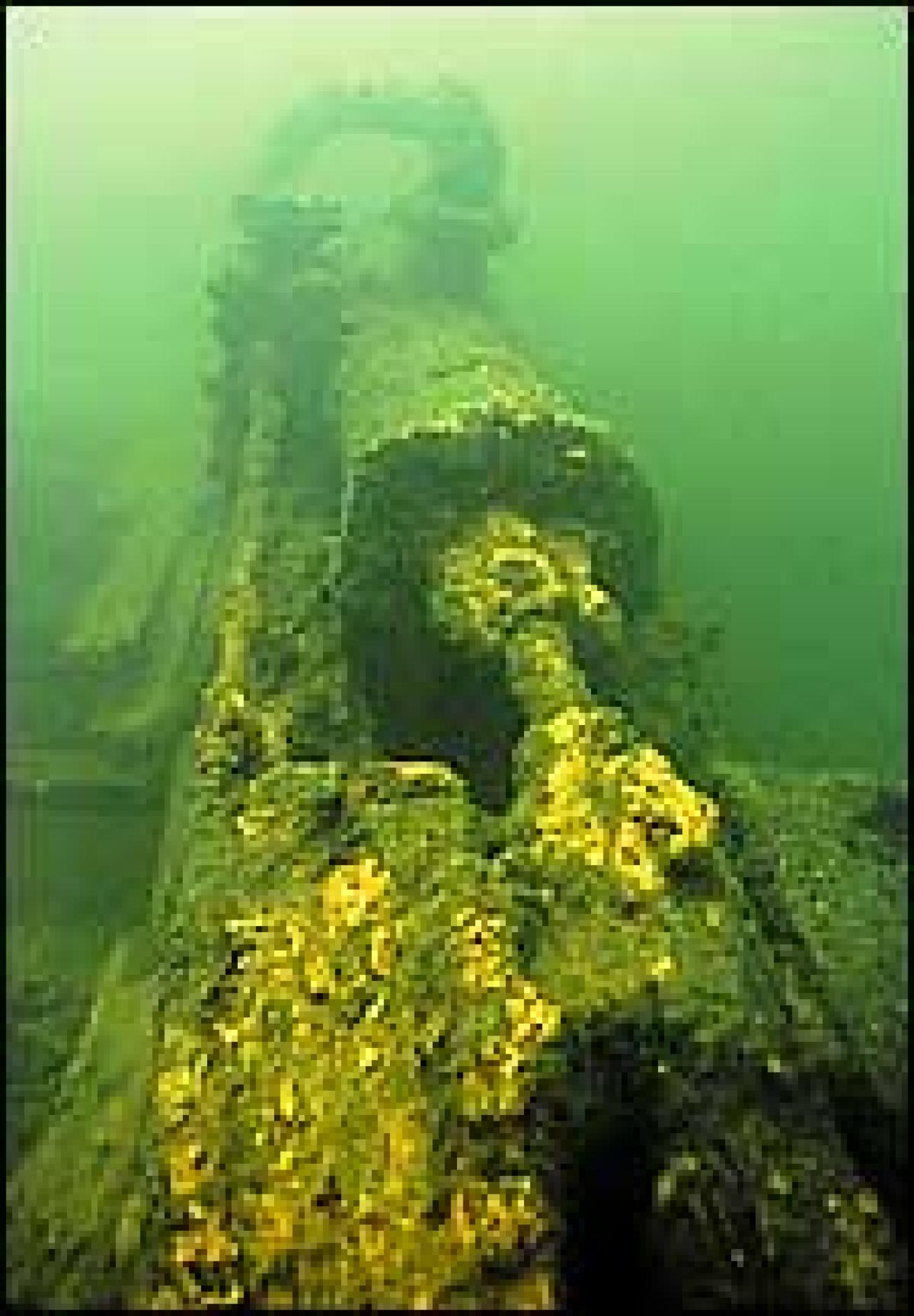
City of Hawkinsville wreck beneath the Suwanee River.
History: Before highways and railroads revolutionized transportation, the best way in and out of north-central Florida was by steamboat. From 1834 to the 1920s, nearly 50 vessels traveled the Suwannee River delivering everything from mail to passengers to commercial goods.
Put into service in 1900 hauling timber, the 141-foot-long City of Hawkinsville was one of the largest riverboats to cruise the Suwannee, and one of the last. It's believed that Hawkinsville delivered materials used to build the railroad trestle that would link the area to the outside world and ultimately put riverboats out of business. The steamboat was abandoned and sank in 1922, forgotten until local divers began exploring the wreck in the 1960s.
Dive: City of Hawkinsville is located on the west bank of the Suwannee River about 100 yards south of the Old Town railroad trestle. Her wooden hull and paddle wheel are remarkably intact and her steel machinery well-preserved.
Access to the site is by boat only. Although the dive is only 18 feet deep, swift currents and low vis (usually less than 10 feet) make it an advanced dive. Sharp edges and tangles of fishing line on the wreck make gloves, an underwater light and a knife mandatory.
Details: Check river conditions by calling the Suwannee River Water Management District at (800) 226-1066. Delay the dive if the river is high or if the visibility is less than three feet. For wreck information, call the Fanning Springs Chamber of Commerce, (352) 463-9089, or Suwannee River Scuba, (352) 463-7111.
Urca de Lima
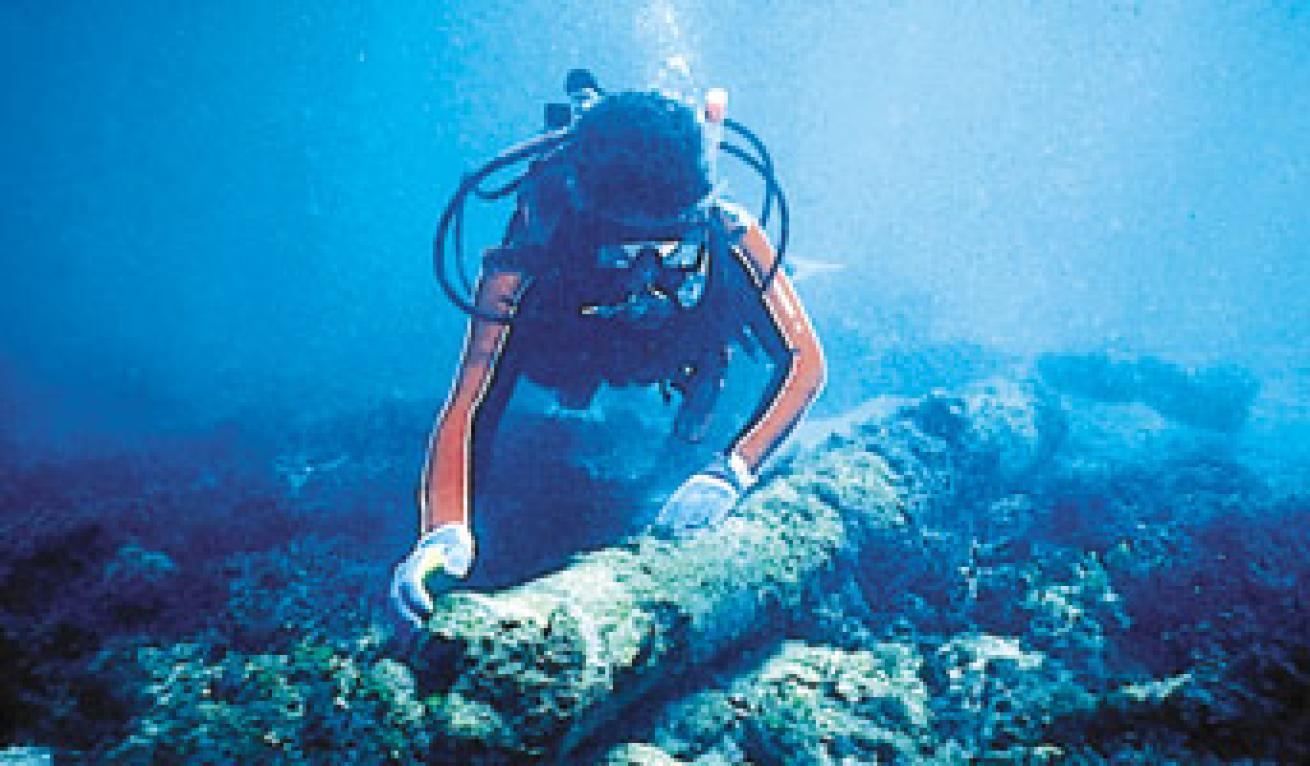
A 1715 hurricane sank the Spanish merchant ship Urca de Lima.
Location:** About half a mile north from the Fort Pierce Inlet and Pepper Park.
History: In the 1700s, Spain retained world-power status largely through the treasure it extracted from the New World. The Florida peninsula served as a convenient landmark that ships would follow north before turning east to cross the Atlantic.
In 1715, this Spanish merchant ship was part of an 11-ship flotilla that would never make the crossing. Caught in a hurricane, Urca de Lima crashed onto a shallow reef near what is now Fort Pierce.
Dive: The wreck site lies 200 yards from shore in the first reef line. With a maximum depth of about 15 feet, Urca de Lima is a favorite site for beach divers and snorkelers. Five replica cannons have been placed near the wreck to enhance the area. The best time to visit is during summer months when seas are calm and visibility peaks at 50 feet. Typically, there is no current and waters generally average in the 80Fs.
Details: Admission and parking are free at the park. Dive Odyssea, (561) 460-1771, caters to those interested in visiting the site and supplies brochures and guides. Artifacts from the wreck are on display at St. Lucie County Historical Museum (561-462-1795), the Museum of Florida History (904-488-1484) and McLarty Treasure Museum (561-589-2147).
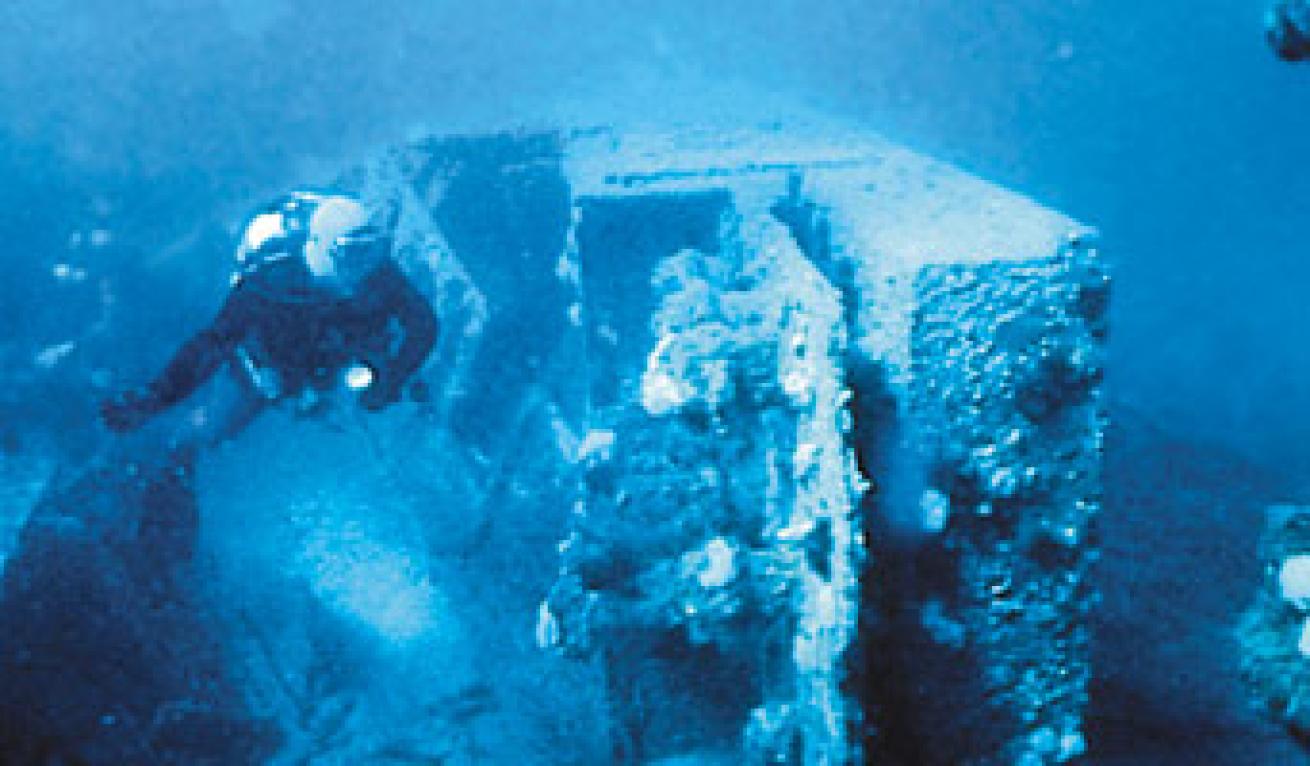
Still sturdy after all these years, the steel wreckage of USS Massachusetts is a popular diving and fishing site.
San Pedro
Location: Off Islamorada in the Florida Keys National Marine Sanctuary, a little over one mile south of Indian Key.
History: Another storm victim, this Spanish ship sank in the Florida Keys during a 1733 hurricane. Loaded with silver and porcelain, the 287-ton galleon was traveling in an armed convoy on its way back to Spain. The fleet was heading through the Straits of Florida on its way back to Spain when the deadly storm hit. San Pedro and all but one of her 21 companion ships were tossed onto the reefs. Rescue vessels from Cuba recovered the cargo and refloated many of the vessels, but the San Pedro was too heavily damaged.
Dive: San Pedro sits in 18 feet of water in the Florida Keys National Marine Sanctuary where she is marked with mooring buoys. Snorkelers and divers can swim over the coral-shrouded ballast stones of the wreck, which swarms with tropical reef fish. Shallow depths, clear water and the absence of currents make the wreck an easy site for divers of all skill levels.
Details: Brochures and underwater guides are available from local dive shops, including Lady Cyana Divers, (305) 664-8717, and Bud 'n Mary's Dive Center, (305) 664-2211.
SS Copenhagen
Location: South of Hillsboro Inlet, off Pompano Beach.
History: In the late 1800s, sailors didn't entirely trust steam power, so most ships were double-rigged as sailing vessels--just in case. This single-screw steamer, built in 1898, was no exception. The 325-foot steel-hulled ship was rigged as a schooner, but the real power came from three triple-expansion steam engines.
A navigational error ended the ship's career as a trans-Atlantic cargo hauler on the morning of May 26, 1900. Copenhagen was en route from Philadelphia to Havana when she ran too close to shore and slammed into the reef at eight knots--her full speed. The ship was declared a total loss.
Dive: The wreck is in 15 to 30 feet of water just outside the second reef line near the Pompano Drop Off. Much of the ship's structure has been overgrown by a reef that is home to everything from tropical fish to sea turtles and lobster. Accessible by beach or boat, Copenhagen is a great shallow dive and snorkel site. Visibility varies due to the close proximity to the inlet, but water is clearest on an incoming tide.
Details: Pro Dive International, (800) PRO-DIVE, and Lighthouse Dive Center, (954) 782-1100, offer charters to the wreck.
SS Tarpon
Location: Gulf of Mexico, just over nine miles from the Panama City jetties.
History: For 35 years, SS Tarpon was a regular fixture along the Florida Gulf Coast. The 130-foot steamer made weekly cargo and passenger runs to six Panhandle ports between Mobile, Ala., and Panama City, and Capt. Willis Barrow took great pride in maintaining strict schedules regardless of the cargo or the conditions. He was quoted as saying, "God makes the weather, and I make the trip."
On Aug. 30, 1937, the ship departed on its final cruise. Loaded at Mobile with 200 tons of general cargo, the Tarpon headed east. At Pensacola, she took on more cargo, including 200 barrels of fuel oil and 15 tons of fresh water, wallowing out into rising seas with barely five inches of freeboard. By the next morning, a full gale was blowing and the bilges could no longer keep up with a leak in the hull. Swamped below decks, the ship began to list and settle in the water despite attempts to lighten the load and run the ship toward shore. Eighteen people--including the 81-year-old Barrow--were lost.
Dive: Tarpon lies on a sandy bottom in 95 feet of water, situated parallel to shore. The site is accessible by boat year-round, and water clarity is generally good. During the summer, seas are usually calm with temperatures in the 80Fs. The wreck also offers a wealth of sea life including big amberjacks, barracuda and large schools of baitfish.
Details: Brochures and guides are available at the Tarpon display in the Museum of Man in the Sea, Panama City Beach, (850) 235-4101. Several Panama City dive shops visit the wreck, including Hydrospace Dive Shop, (850) 234-3063, and Panama City Dive Center, (850) 235-3390.
Half Moon
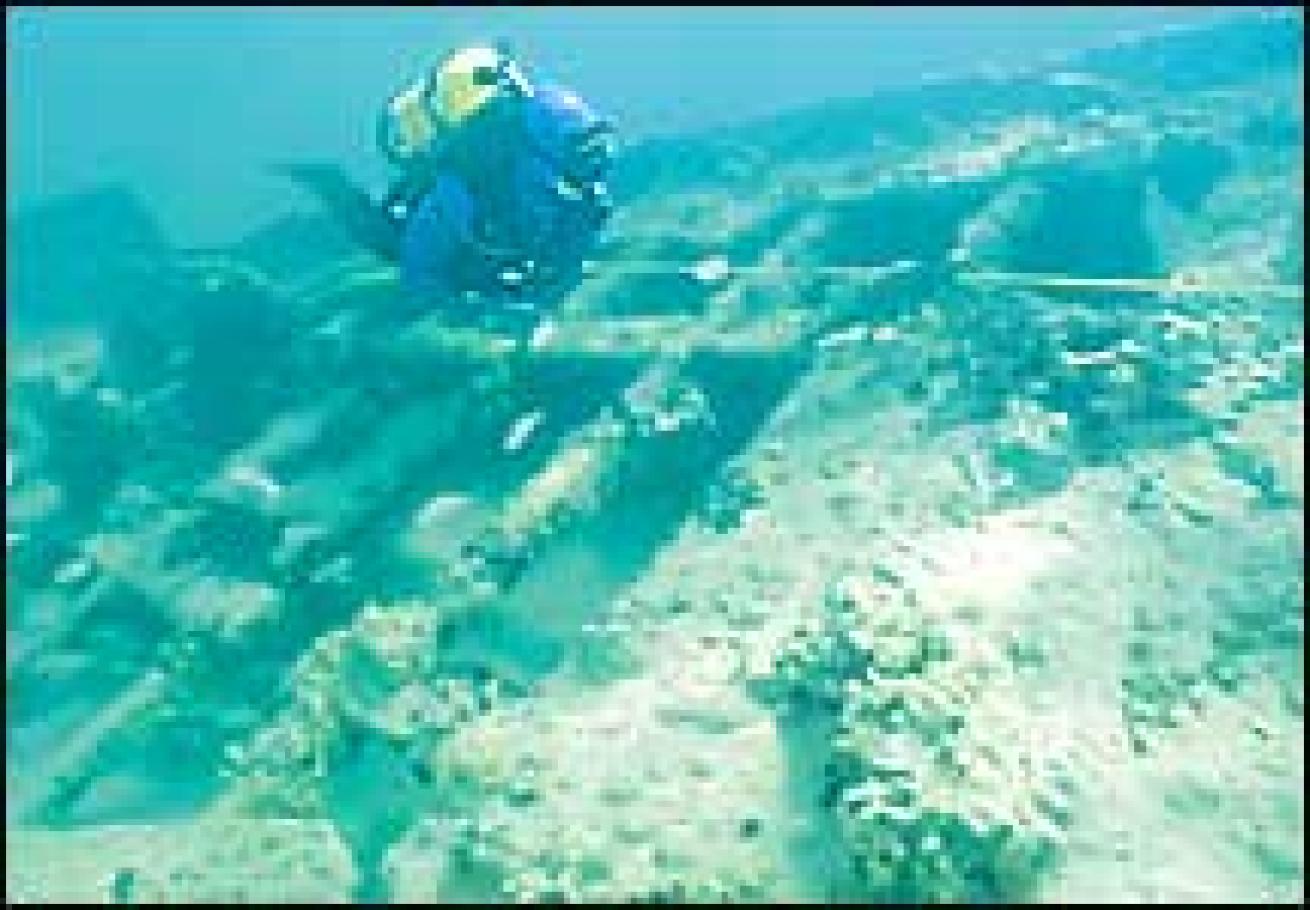
The newest state preserve is the wreck of the sailing yacht Half Moon near Key Biscayne.|
History: An aristocrat's plaything, a spoil of war and a floating saloon--all roles played by this fast 154-foot luxury schooner.
Christened in 1908 as Germania, the yacht was a wedding gift to a German count, and she became famous in European racing circles. The ship happened to be in Cowes, England, for a regatta at the outbreak of World War I and was seized as a prize of war. Auctioned off, the boat changed hands, names and ports before ending up in Miami in the late 1920s. By 1930, the once-proud yacht was a floating cabaret and fishing barge anchored off Miami, but a storm that year ripped the boat free of her moorings and smashed it onto a shoal.
Dive: Today, the wreck lies broken, but the partially buried hull is still largely intact and many distinct features of the wreck are recognizable. A popular site with snorkelers, the wreck is in 10 feet of water and covered with soft corals and sponges.
Details: The newest of the preserves, Half Moon was to be officially designated in February 2001. A museum display of the wreck, including the ship's original bell, will be on display in the new Biscayne Nature Center, (305) 642-9600. Access to the wreck is available by private boat or Miami-area dive shops, including South Beach Divers, (305) 531-6110.
The Rules
Look, But Don't Take.
It's illegal to disturb or remove artifacts from all shipwrecks in state waters, including the underwater archaeological preserves.
Fly the Colors.
State law requires divers to fly a dive flag and stay within 100 feet of it.
No Anchors.
All underwater archaeological preserves, except the USS Massachusetts, are marked with mooring buoys to prevent anchor damage to the wrecks. If necessary, anchor in the sand away from the wreck to avoid damage.
What is a State Underwater Archaeological Preserve?
In 1987, the State of Florida began designating wrecks as archaeological preserves in order to protect sites from damage and to promote visits by divers.
"These wrecks are like time capsules. They freeze a particular moment of Florida's maritime history," says Dr. Roger Smith, state underwater archaeologist with the Division of Historical Resources. "As divers we all need to protect our submerged cultural resources so that future divers can share in the excitement of Florida's maritime history."
Each wreck site is marked with an underwater plaque and most have mooring buoys, while brochures detailing the wreck's history and laminated site guides are available at tourist centers, local museums and dive shops.
For more information or to nominate a wreck as a preserve, contact Della Scott at (850) 487-2299.


